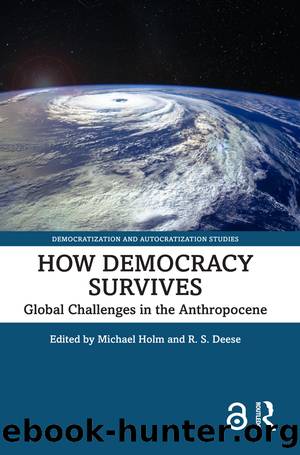How Democracy Survives by Michael Holm & Deese R. S

Author:Michael Holm & Deese, R. S.
Language: eng
Format: epub
Publisher: Taylor and Francis
Published: 2022-11-30T11:07:17+00:00
He added a bold statement: âIf it hadnât been for Union Now, I donât think that there would have been a NATO Treaty.â
After the disappointment of 1945 with the UN, Union Now had kept alive this hope of Achillesâ generation that the door to world organization through democracy was still open and could eventually lead to federation. The prospect of a federal union of democracies, Achilles (1972) reported, was the reason for his and Hickersonâs âshared enthusiasm for negotiating a military alliance and getting it ratified as a basis for further progress towards unity.â
Back when he started as a correspondent at the League, Streit gained international attention in 1932 with a provocative report on freedom of the press and the Leagueâs role in contributing to âfalse newsâ (Streit, 1932, 16â27). Two years later, the reflection on truth and peace at the core of that report was particularly relevant for the moral and ethical foundations of his proposal for a union of democracies. Federalism in international organization would eradicate the moral dilemmas in the otherwise mandatory choices among peace, truth, and democracy. The participatory processes of federation allowed internal reconciliation of perspectives; they also transformed the outlook of the external âenemyâ relation. At the other end of the spectrum from a Carthaginian peace was peace by federation, resting on validation and inclusion of the âotherâsâ truth in the formation of the shared rule of the whole. This prospect offered a qualitatively different incentive to democratization, which stemmed, Streit maintained, from the natural aspiration that our truth, individual and societal, be given agency.
Streit (1939, 155) believed that the âprovision for ultimate universality on the basis of equality among all the citizensâ would break the cycle that, through âdespair or offended pride,â led unstable democracies back âinto the hands of the absolutists.â The nucleus âwould need no propaganda bureau.â Endogenous democratization would occur with freedom of the press and methods of world organization could either facilitate or undermine its emergence. âWould not the establishment of genuine freedom of the press,â Streit asked, âin, say, Soviet Russia, be hastened by the wish to join this world organization?â
If history can serve as an indicator, however incomplete, Streitâs predictions seem somewhat vindicated. Peace with Germany, Italy, and Japan, consolidated through institutional integrative bonding, immediately following WWII, eliminated the enemy-relation. In contrast a high-powered enmity relation reemerged with Russia, following a lack of institutional integration after the end of the Cold War. In 1954, Streit (p. 254) warned against the likely resurgence of âaggressive dictatorship and warâ if âbefore the free are organically federated, revolution should sweep through Soviet Russia and its satellites and replace the Communist dictatorships with Western-type democracies or chaos.â That scenario, he commented, âwould not end the basic tension of our time.â It would reinstate, rather, a situation of international anarchy similar to that in existence after WWI, when, years ahead of the lead-up to WWII, he wrote Union Now. In calling for a federal union of democracies, then and again in 1954,
Download
This site does not store any files on its server. We only index and link to content provided by other sites. Please contact the content providers to delete copyright contents if any and email us, we'll remove relevant links or contents immediately.
The Secret History by Donna Tartt(18945)
The Social Justice Warrior Handbook by Lisa De Pasquale(12165)
Thirteen Reasons Why by Jay Asher(8841)
This Is How You Lose Her by Junot Diaz(6833)
Weapons of Math Destruction by Cathy O'Neil(6214)
Zero to One by Peter Thiel(5731)
Beartown by Fredrik Backman(5673)
The Myth of the Strong Leader by Archie Brown(5456)
The Fire Next Time by James Baldwin(5380)
How Democracies Die by Steven Levitsky & Daniel Ziblatt(5170)
Promise Me, Dad by Joe Biden(5112)
Stone's Rules by Roger Stone(5051)
A Higher Loyalty: Truth, Lies, and Leadership by James Comey(4905)
100 Deadly Skills by Clint Emerson(4879)
Rise and Kill First by Ronen Bergman(4739)
Secrecy World by Jake Bernstein(4698)
The David Icke Guide to the Global Conspiracy (and how to end it) by David Icke(4655)
The Farm by Tom Rob Smith(4465)
The Doomsday Machine by Daniel Ellsberg(4449)
